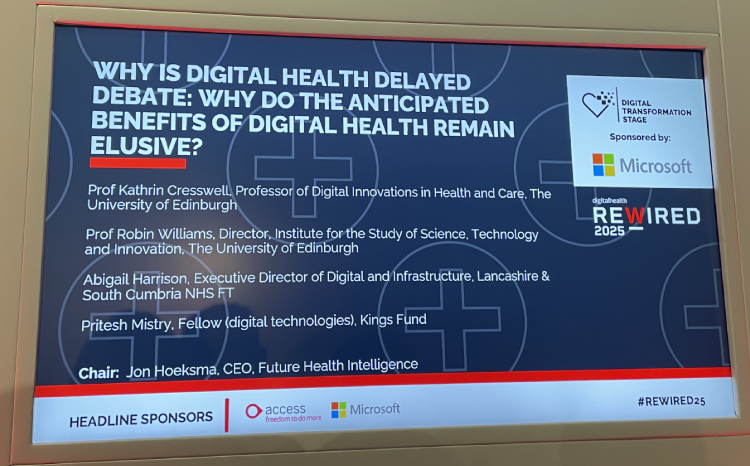No more stop gaps: Why it’s time to change the focus on digital
- 30 November 2021

It is no secret that the Covid-19 outbreak has helped drive the digital agenda across the NHS, but what will happen in the post-pandemic world? Lord Victor Adebowale, chair of the NHS Confederation and co-Founder and chairman of Visionable explores what digital transformation needs to look like moving forward and why it is so important to ensure it is beneficial for clinicians and patients.
We all learnt pretty quickly during the pandemic that digital solutions can be used to provide a quick resolution to health and care delivery. Within weeks we saw technology platforms installed to help professionals and clinicians to respond in a proactive and effective way.
However, what Covid has also demonstrated, is that the introduction of rapid technology provides only temporary relief to the high-pressure health systems are facing, and, to sustain this momentum and provide long-term gain, we need a different approach to digital implementation. The ‘stop-gap’ solutions have led to many conversations about whether digital can protect health and care from its gradual decline.
On its own, I do not believe it can. In order to be the redeemer, it needs the collaboration of all its stakeholders – clinicians, commissioners, innovators and patients. It also needs to deliver interventions in each part of the patient journey, providing opportunities for digital care, from one end to the other; it needs a sustainable and holistic solution – and one which puts people first.
Shift the focus from acute care
Take brain injury, including stroke, as a case in point. Digital platforms in this pathway already have a proven track record on the acute end. This is not surprising as this is where the investment is – and always has been. There are excellent examples of high quality, clinical grade digital platforms supporting a virtual health and care system, at the acute phase of this pathway.
Over the last ten years, we have seen some real benefits in the East of England using digital solutions to deliver ischemic stroke treatment, therefore improving outcomes. Lives have been saved by having access to accurate diagnosis and treatment at the point of need and through smart ambulances to speed-up acute care.
But we really need to shift the focus and concentrate on designing and implementing digital interventions in other segments of the pathway. There is a massive digital opportunity to optimise outcomes for people – especially in recovery – and provide a blueprint for other interventions to follow.
Accelerate the recovery plan
Sadly, when we refer to the basic conversations we have had, it’s very clear that treatment and recovery programmes are pretty inconsistent. This is apparent across the world and not just in the UK.
A report from the charity SameYou, captures and shares hundreds of real life stories and provides insight into people’s experiences of recovery and rehabilitation following an acquired brain injury or stroke.
Their stories have shown that outcomes are much more positive for those with multiple interventions, including remote monitoring, access to therapies, centralised services in specialist units and peer-to-peer support.
We really should be showcasing those stories, to enhance the digital offer and accelerate the introduction of virtual rehabilitation platforms, which in turn will reduce the need for longer-term care. The savings could be substantial, but more importantly, it could have a profound impact on people’s lives.
Yet despite the evidence and efforts, we still seem to fall short.
With the initiation of 21 Integrated Stroke Delivery Networks (ISDN) in the UK, there is hope that there will be some co-ordination of innovations within and between the Integrated Care systems (ICS), to facilitate a sustainable cohesive response.
However, there is no evidence that this is starting to take shape anytime soon. In fact, the continued focus on Acute Stroke Units seems to reiterate the treadmill of investment in crisis management, rather than prevention and rehabilitation.
It was also hoped that the post-Covid learnings would re-ignite the ambitions of the NHS Long Term Plan, to improve post-hospital rehabilitation models – but again this is happening at a slow pace.
As innovators and influencers, we need to accelerate this plan.
By supporting people at home and providing earlier intervention we can help prevent deterioration, particularly as people are faced with long waits for care. This in turn will reduce readmissions and exacerbation, but also reduces unnecessary low value follow-ups.
The benefits are therefore substantial; with a focus on health promotion and wellbeing and lifestyle optimisation, it will reduce demand on primary and community care as well as overall healthcare utilisation.
And, what’s more, the information captured can feed back into the overall pathway design in order change clinical practice and inform systems for future population health management.
Closing the virtual circle
Integrated health and care delivery cuts across the whole system – bringing in both formal and informal care.
Our communities – including digital ones – can play a key role in lifestyle changes and choices. Prevention and recovery is not even a technology challenge, it is a societal one. Race, geography and politics has a huge effect on the possibility of suffering from long term conditions and access to treatment, however, we need to capture the data and information throughout the pathway in order to change that.
At the moment the data sets are not being passed on and do not discern between people from one end of the pathway to the other, therefore a patient is not seen as the same person, rather as a different episode. This lack of integration often is the missing link to complete pathway design and needs to be addressed.
We should also be encouraging innovative strategies and technologies to detect and address physical and socio-economic risk factors for stroke, and the impact of health inequalities when managing high risk groups. Only then can we identify what interventions are high cost and high impact.
So where to from here?
Firstly, we need a digital footprint to follow the patient, and focus on the whole person. If we have this, we will then see the shift and impacts on all other pathways.
By optimising the platforms we have and focusing on rapid treatment and effective recovery, we can build the evidence on prevention and contribute to the debate.
In addition, the advent of digitally enabled rehabilitation with patient centred care at its heart, can reduce the costs of rehabilitation hugely, and thus enable the NHS and care system to properly fund this element of the pathway.
By taking the lessons learned from the pandemic to speed up digital collaboration and to organisations to commission technology as part of a complete operating model, not as an addition to an existing model, we can truly make a difference. And it needs to be more than just in acute care, and with more than just clinicians.
It is time to shift focus and invest in people; helping them to be well and stay well. Digital can help – it can be lifesaving and life-changing in so many ways – but it can’t do it alone.





4 Comments
I agree with the majority here. It conveys little to me at all; just a word exercise.
There is a lot to like about this, but the problem in practice is that any digital device that delivers therapy is a medical device and until recently they were all ‘self certified’ and we all know what that means.
We have now started using the Neuroproactive platform which is a properly certified device, but it does still seem like the Wild West in digital device land.
Sadly this article doesn’t contribute to much.
More plain english would help. What exactly is meant by “a digital footprint to follow the patient”?
^ this. What does it mean? What would it do? I’m genuinely curious.
Comments are closed.